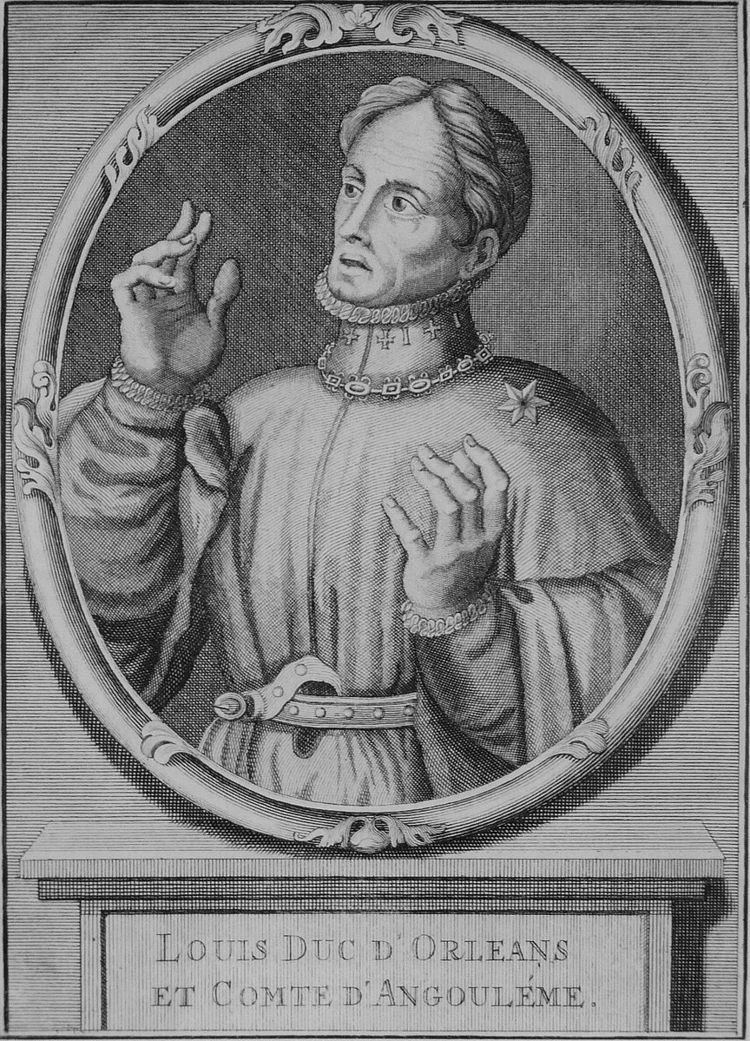Reign 1392–1407 | Name Louis I of Orléans | |
 | ||
Born 13 March 1372 ( 1372-03-13 ) Burial Saint Denis Basilica, France Issue Charles, Duke of OrleansJohn, Count of AngoulemePhilip, Count of VertusMargaret, Countess of Etampes and Vertus | ||
Louis I of Orléans (13 March 1372 – 23 November 1407) was Duke of Orléans from 1392 to his death. He was also Count of Valois (1386?–1406), Duke of Touraine (1386–1392), Count of Blois (1397–1407), Angoulême (1404–1407), Périgord (1400–1407) and Soissons (1404–07).
Contents

Louis was the second born son of King Charles V of France and Joanna of Bourbon and younger brother of Charles VI.
Succession in Hungary, Poland and Naples
In 1374, Louis was betrothed to Catherine, heiress presumptive to the throne of Hungary.
Louis and Catherine were expected to reign either over Hungary or over Poland, as Catherine's father, Louis I of Hungary, had no sons. Catherine's father also planned to leave them his claim to the Crown of Naples and the County of Provence, which were then held by his ailing and childless cousin Joanna I. However, Catherine's death in 1378 ended the marriage negotiations. In 1384, Elizabeth of Bosnia started negotiating with Louis' father about the possibility of Louis marrying her daughter Mary, notwithstanding Mary's engagement to Sigismund of Luxembourg. If Elizabeth had made this proposal in 1378, after Catherine's death, the fact that the French king and the Hungarian king did not recognise the same pope would have presented a problem. However, Elizabeth was desperate in 1384 and was not willing to let the schism stand in the way of the negotiations. Antipope Clement VII issued a dispensation which annulled Mary's betrothal to Sigismund and a proxy marriage between Louis and Mary was celebrated in April 1385. Nonetheless, the marriage was not recognised by the Hungarian noblemen who adhered to Pope Urban VI. Four months after the proxy marriage, Sigismund invaded Hungary and married Mary, which ultimately destroyed Louis' chances to reign as King of Hungary.
Hundred Years' War
Louis had an important political role during the Hundred Years' War. With the increasing insanity of his elder brother Charles the Mad (who suffered from either schizophrenia, porphyria or bipolar disorder), Louis disputed the regency and guardianship of the royal children with John the Fearless, Duke of Burgundy. The enmity between the two was public and a source of political unrest in the already troubled France. Louis had the initial advantage, being the brother rather than the first cousin of the king, but his reputation as a womaniser and the rumour of an affair with the queen consort Isabeau of Bavaria made him extremely unpopular. For the following years, the children of Charles VI were successively kidnapped and recovered by both parties, until the Duke of Burgundy managed to be appointed by royal decree guardian of Louis, the Dauphin and regent of France.
Louis did not give up and took every effort to sabotage John's rule, including squandering the money raised for the relief of Calais, then occupied by the English. After this episode, John and Louis broke into open threats and only the intervention of John of Valois, Duke of Berry and uncle of both men, avoided a civil war.
Murder
On Sunday 20 November 1407, the contending Dukes exchanged solemn vows of reconciliation before the court of France. But only three days later, Louis was brutally assassinated in the streets of Paris, by the orders of the Duke of Burgundy John the Fearless. Louis was stabbed while mounting his horse by fifteen masked criminals led by Raoulet d'Anquetonville, a servant of the Duke of Burgundy. The unarmed servants who escorted him were powerless to protect him—his page tried to protect Louis and was mortally wounded. An attendant was severely wounded.
John was supported by the population of Paris and the University. He could even publicly admit the killing. Rather than deny it, John had the scholar Jean Petit of the Sorbonne deliver a peroration justifying the killing of tyrants.
Louis' murder sparked a bloody feud and civil war between Burgundy and the French royal family which divided France for the next seventy years, and only ended with the death of Charles the Bold, Duke of Burgundy in 1477.
Marriage and Issue
In 1389, Louis married Valentina Visconti, daughter of Gian Galeazzo, Duke of Milan. The union produced eight children:
His illegitimate son by Mariette d'Enghien was "Jean Levieux Valois des Orléans", better known as John of Dunois (1402–1468), ancestor of the Dukes of Longueville.
